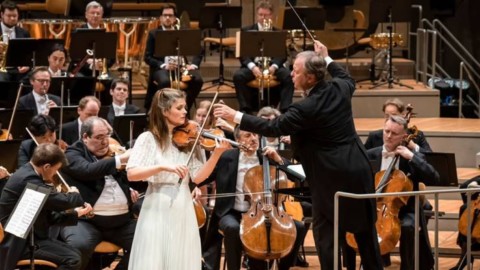Classical period
VERSION FRANCAISE DISPONIBLE. VEUILLEZ CLIQUER SUR L'ICONE (BAS DE PAGE)
DEFINITION
Classicism covers a period of about 70 years, from 1750 to 1820, which follows the Baroque period and precedes Romanticism, to which it is often opposed. This period is dominated by what some call the "holy triad" of Viennese classicism: Haydn, Mozart and Beethoven.
Concerning musical forms, the classical period sees the triumph of the sonata form, which is found in the sonata itself but also in quartets, concertos and symphonies. These new musical genres will be used throughout the 19th century and again in the 20th century.
Italian opera, for its part, is questioned by Gluck, then by Mozart.
Classical intruments

The classical orchestra of Haydn and Mozart is built on two main families of instruments:
- The string group made up of a dozen violins divided into two parts (1st and 2nd violins), from two to seven violas, from two to eight cellos and from two to five double basses.
-
The woodwind group most often includes three music stands, in pairs: two flutes, two oboes and two bassoons.
With Beethoven, percussion and brass are then added: timpani, 2 trumpets, 3 trombones, 4 horns, triangle, cymbals, bass drum (9th symphony).
Voices

The “star” instruments of the classical era are the piano and the clarinet, but also the voices which are at the center of the opera, in particular with Mozart, either as a soloist, duet, trio… or in chorus.
Voices are classified into female voices and male voices, high, medium and low.
These voices are:
- The sopranos, or high-pitched voices of women and children. Example: Natalie Dessay, light coloratura soprano, in the aria of the Queen of the Night from Mozart's The Magic Flute.
- Mezzo-sopranos, or medium voices of women and children.
- Contraltos, (also called alto) or deep female voices with moving inflections. Example: Nathalie Stutzmann in Venga pur minacci e frema from Mozart’s “Mitridate, re di Ponto”
- Tenors, or high male voices. Example: David Kuebler, light tenor, as Paolino in The Secret Marriage of Cimarosa.
- Baritones, or average male voices.
- Bass, corresponding to the deep voices of men. Example: Kurt Moll, profundo bass, as Sarastro in O Isis und Osiris from Mozart's “The Magic Flute”
Other composers
C-W Gluck (1714-1787)
Christoph-Willibald Gluck was born in 1714 in Bavaria. He was above all an opera composer. He was at the origin of a reform of opera, which he implemented with the librettist Ranieri Calzabigi by creating together Orphée Eurydice in 1762, then Alceste in 1767. He then applied his Reform in Paris with “Iphigénie en Aulide”,
which will achieve great success.
C.P.E. Bach (1714-1788)
C.P.E. Bach composed numerous symphonies, concertos and sonatas. He makes the link between the baroque style of his father Johann Sebastian Bach, and the classical style of Haydn and Mozart, and is considered the initiator of modern instrumental music.
Luigi Boccherini (1743-1805)
Luigi Boccherini was the greatest cellist of his time.
He is best known for his chamber music and in particular for his numerous quintets, but he also composed concertos for cello, violin and harpsichord, as well as symphonies and religious music.
Muzio Clémenti (1752-1832)
Clémenti is the first great composer for the piano: He is the link between the baroque of Scarlatti and the romanticism of Beethoven, and his sonatas probably influenced the latter. His “Gradus ad Parnassum” which included 100 studies was a major work of piano teaching in the 19th century.
Leopold Mozart (1719-1787)
Best known as the father and teacher of Wolfgang Amadeus Mozart, he was famous in his day for his violin method written in 1756, the year Wolfgang was born.
Among his 550 works, some demonstrate a certain originality by introducing sounds of nature,
as in the “Hunting Symphony” where he uses rifle shots and dog barking, the “Musical Sleigh Ride” with bells and horse neighing, the “Peasant Wedding” suite with shouts, whistles and music. hurdy-gurdy.
Johann Christian Bach (1728-1800)
Johann Christian Bach, ten-eighth and last son of Johann Sebastian Bach, was one of the first keyboardists to play the pianoforte and to compose for this new instrument. His catalog numbers around 360 works, including operas, sacred music, keyboard music, chamber music, symphonies and concertos.





